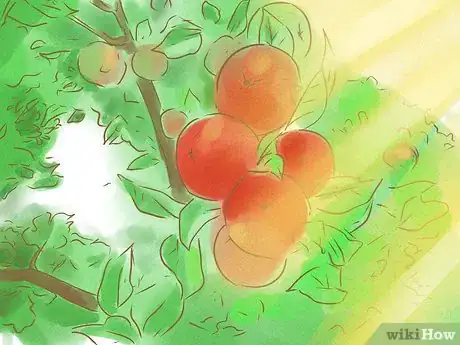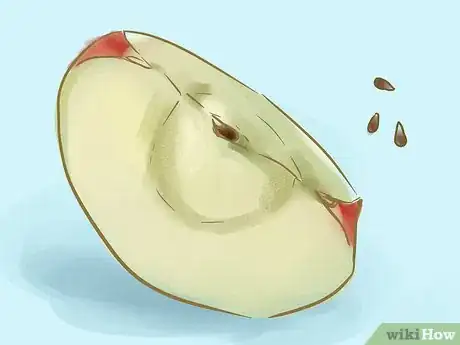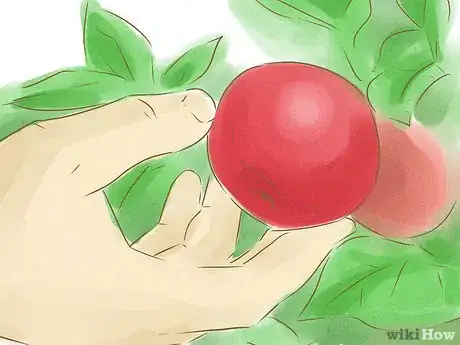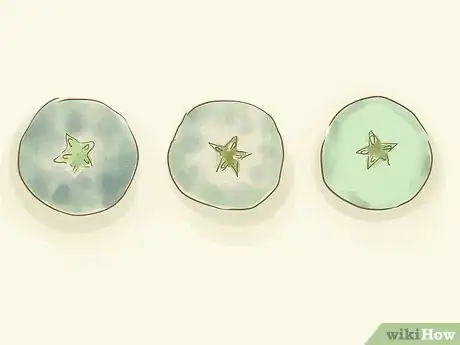wikiHow is a “wiki,” similar to Wikipedia, which means that many of our articles are co-written by multiple authors. To create this article, volunteer authors worked to edit and improve it over time.
There are 7 references cited in this article, which can be found at the bottom of the page.
wikiHow marks an article as reader-approved once it receives enough positive feedback. This article has 16 testimonials from our readers, earning it our reader-approved status.
This article has been viewed 159,736 times.
Learn more...
Apples ripen at various times throughout the year, depending on the type of apple tree, the weather and where the apples are located on the tree. While the apples may ripen a little sooner or a little later each year, depending on the weather, they will generally be ready for harvest around the same time each year; if they were ripe in November last year, they should be ready to pick around the same time this year. When you are not sure when they were ready to pick last year, what type of apple tree you have, or when the apples are usually ready for harvest in your area, there are some tell-tale signs you can look for that indicate that the apples are ripe.
Steps
Learning to Identify Ripe Apples
-
1Take the growing location into account. Apples are ready for picking earlier in warmer areas than the fruits in colder climates because the heat helps them ripen. Likewise, south-facing fruits will get more sunlight and be ready for picking earlier than apples on the north side of the tree.[1]
- In cooler climates, harvest time is generally September through October.
- In warmer climates, harvest time could be anywhere from late summer through early spring.
-
2Consider the color of the apples. The most obvious sign to watch for is color. Golden delicious apples will change from green to yellow when they are ready to be harvested and red delicious will turn entirely red. If the tree produces apples with stripes or red blush, the green part of the apple will turn yellow when it is ready to pick.[2]
- Unfortunately, some of the newer apple tree cultivars are not so obvious. The skin on these apples may turn entirely red before they are ready for harvest or the green part of the skin may not turn yellow until the apples are stored for a few months. To overcome this obstacle, heck the flesh of the apple before harvesting all of them to determine if they are ready. When these apples are ready to harvest the flesh will have changed from pale green to white.
- The color of the indentation near the stem is another way to tell on certain varieties. The shade of this area generally lightens as the apples ripen.[3]
Advertisement -
3Wait for a couple of apples to fall from the tree. Apple trees naturally drop their apples when they are ripe to self-seed and reproduce. Watch for an apple or two to drop from the tree to determine if they are ready to pick.[4]
- When your apples are ripe, they should be fairly easy to pick from the tree with a simple upward twist of the apple.[5] Try to avoid picking an apple by pulling the fruit straight down and tugging.
- If otherwise healthy fruits begin to fall off the tree, they are probably beginning to get a little too ripe and should probably be harvested as soon as possible.
-
4Look for dark brown seeds inside the apple. Apples that are nearing maturity will generally have dark brown seeds rather than white ones. However, keep in mind that this may not be the case for varieties that ripen early. Their seeds may still be light-colored when they are ripe and some types have seeds that turn brown weeks before the optimal picking time. This is where researching the variety in your yard can also prove helpful.[6]
Testing for Ripeness
-
1Do a taste test. The ultimate test of ripeness is the taste test. The flesh should be sweet or tart, depending on the apple variety, and slightly softer but not mushy.
- Don’t be discouraged if all signs point to harvest time but the apples are not as sweet as they should be, especially if they are a type of Delicious apple. Some types of apples will get sweeter after they are picked and stored for a short while.
-
2Test the apple for softness. Apples that are fully matured are also slightly softer in texture than unripe apples. A good way to test a fruit’s ripeness is by giving it a light squeeze between your fingers and thumb. If the apple indents a little then it is finished growing. It may take novice gardeners sometime before they become proficient with this test, however.
-
3Spray the inside of the apple with iodine. If all else fails, gardeners can cut an apple through the core and spray it with iodine to see if it is ripe. Iodine will turn the unripe cells a dark color due to the presence of starch in the apples. Fruits that are to be stored should have a completely white center and dark spots that take up anywhere from three quarters to one half of the fruit. Completely clear fruits should be immediately eaten or preserved in some fashion.[7]
Community Q&A
-
QuestionWhat causes apples to rot on the tree?
 Community AnswerPests and bugs, being overripe, being eaten by animals, and not having required nutrition are the main reasons that cause apples to rot on the tree.
Community AnswerPests and bugs, being overripe, being eaten by animals, and not having required nutrition are the main reasons that cause apples to rot on the tree. -
QuestionHow can I make apples sweeter?
 Community AnswerAdd sugar to them after they have been cut, then let the apple absorb the sugar.
Community AnswerAdd sugar to them after they have been cut, then let the apple absorb the sugar. -
QuestionShould apples be exposed to frost before you pick them?
 Fae LynneCommunity AnswerSome people claim it makes them sweeter, but if you're storing them in dry storage for winter, then it might make them rot faster.
Fae LynneCommunity AnswerSome people claim it makes them sweeter, but if you're storing them in dry storage for winter, then it might make them rot faster.
Warnings
- Apples that are to be stored will need to be picked before they reach their peak ripeness so that they will last longer in storage. However, apples that are picked too early will end up being sour and tough, if not altogether unpalatable, so gardeners should keep that in mind.⧼thumbs_response⧽
References
- ↑ https://garden.org/learn/articles/view/1574/
- ↑ http://dspace.library.cornell.edu/bitstream/1813/3299/2/Predicting%20Harvest%20Date%20Window%20for%20Apples.pdf
- ↑ https://polk.extension.wisc.edu/files/2014/02/When-are-Apples-Ripe-A3743-E.pdf&s_cid=queue-5
- ↑ https://www.canr.msu.edu/news/why_does_apple_fruit_drop_prematurely
- ↑ http://www.bbc.co.uk/gardening/basics/techniques/growfruitandveg_harvestapples1.shtml
- ↑ https://extension.umaine.edu/fruit/harvest-and-storage-of-tree-fruits/maturity-indicators/
- ↑ http://www.pickyourown.org/apples_howtotellwhenripe.php
About This Article
Apples ripen at different times depending on the climate. If you live in a cool area, expect your apples to ripen in early autumn. In warmer areas, they could become ripe any time from early spring to late summer. Once apples start falling from the tree, they are probably ripe. Some apples change color as they ripen. For instance, watch for golden delicious apples to change from green to yellow. Red delicious apples will change from green to red. If your apples are green or partly green even when ripe, try cutting one open instead of looking at the color of the skin. The flesh of a ripe apple should be white or even slightly pink, but not green. The seeds should also be dark brown instead of white. To learn how to use an iodine test to tell if an apple is ripe, read on!




























































